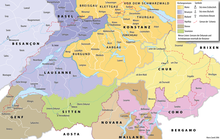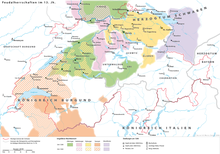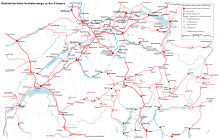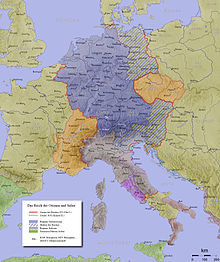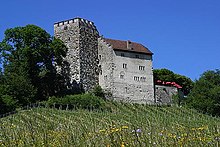Switzerland in the Middle Ages
The history of what is now Switzerland in the Middle Ages begins with the end of Roman rule in 401 AD. It is difficult to determine the end of this era, as the transition from the Middle Ages to the modern era occurred at different times in Switzerland . From a historical point of view, the transition for the entire area of today's Switzerland is to be set with the Reformation in the 16th century. Nevertheless, the end of the Middle Ages is set here with the founding of the Old Confederation in 1291/1315.
Early middle ages
The Great Migration: Alemanni, Burgundy and Romanes
In 401, the withdrawal of the Roman legions from the Rhine Limes ushered in a major political, social and cultural change. The ancient road network, which played a key role in shaping the geopolitical unity of today's Swiss Confederation , as well as the old Roman spatial divisions that survived in the ecclesiastical organization of Switzerland have survived in today's Switzerland.
In the 3rd and 4th centuries AD, the Alemanni were among the most feared opponents of the Romans. That is why many of the novels of ancient Switzerland withdrew from this danger. Around three quarters of the Roman manors (villae) in the Swiss midlands were abandoned. The Romans emigrated to the Alpine valleys or directly to the Italian region. In the Swiss Central Plateau, only a few Romance language islands remained in the area of the former Roman forts until the 7th century. Politically, the country was determined during the time of the Great Migration and afterwards by the Germanic tribes of the Burgundians , the Alamanni, the Franks and, in the south, the Longobards .
The Burgundians had reached the Middle Rhine towards the end of the 4th century. As enemies of the Alemanni, they were settled by the Romans as federates in the Roman Empire. In 436 the Burgundian Empire between the Roman governor Aetius and the Huns was wiped out. The surviving Burgundians were then settled around Geneva and on the north bank of Lake Geneva as far as Lausanne and mixed with the local population. As a minority, the Burgundians were quickly assimilated by the Celto-Roman population. In the 5th century, a new empire of the Burgundians was formed, which extended up to 470 along the Rhone via Lyon to the Durance in Provence . This policy corresponded to the Gallo-Roman nobility of the Burgundian Empire. Between the years 507 and 516 , this empire under Gundobad temporarily extended to almost all of today's German-speaking Switzerland (including Eastern Switzerland); from this time z. B. the not a few place names ending with - ach . After the rise of the empires of the Franks and the Ostrogoths , the Burgundians could no longer hold out and their empire was incorporated into the Franconian Merovingian Empire in 534 .
In the 3rd and 4th centuries, the Alamanni were still feared because of their raids, but after the dissolution of the Western Roman Empire they gradually moved in several settlements to the abandoned Roman cultivated land in the former Limes region and the Swiss plateau. The Alamanni were not an original Germanic tribe, but a Germanic tribal association that emerged in southern Germany from the 2nd century onwards . They could not hold their own against the Burgundians in the south-west, the Bavarians in the east and the Rhine Franks in the north-west, which is why they could only expand into the Helvetic region. Since the kelto-Roman population was less numerous and the Roman structures were weakened, which were Celto novels assimilated by the Alemanni. From 537 the Alemanni also came under Franconian suzerainty.
In the 4th century, the northern edge of the Alps served as a refuge for the Gallo-Roman population, who had to retreat before the advance of the Alamanni. In the late 6th century, the Lombards invaded the southern Alpine valleys, but they were subsequently Romanised. In the 7th century, the Alemannic conquest began south of the Rhine and in the central Alps. At the end of the 8th century, the Alemannic reached Lake Biel and the Saane Valley . Germanization began in Raetia in the 11th century. The Alemannic settlement reached altitudes of up to 1500 meters in the dry zone of the Valais.
Origin of the language regions
(→ Languages in Switzerland )
Originally there was a lot of overlap between the Romanesque and Germanic settlement areas in today's Switzerland - a coexistence and coexistence of cultures - and only very gradually did the language boundaries become clearer. The place names ending in -ingen in the form of -ens or -ence extend to the north shore of Lake Geneva . The Vaud was a mixed language development zone so for a long time. It was not until the 8th century that language boundaries were clearly expressed in the accumulation of whale names. This German place name indicates where "Walchen" / "Welsche", i.e. novels, lived at that time, z. B. Walensee , Walenstadt .
In contrast to the western language border towards French, the movement of the language border in the south in the cantons of Graubünden , Ticino and Valais has not yet been completed. In the Alpine regions of today's Switzerland, Romansh was much more dominant than in the Swiss Central Plateau. In the 10th century, Romansh was still the predominant language in the area around Einsiedeln , in the Rhine Valley , in Uri and in today's Canton of Glarus . The actual land development of the Alemannic settlers in Upper Valais did not take place until the 11th century. It was not until the late Middle Ages that the Walsers migrated here and there in the Alps, and the German language prevailed - mainly in areas that had little contact with the Mediterranean. In Churrätia , the Roman structures survived the longest due to church political conditions. The local population developed their language further into modern Rhaeto-Romanic. Until the modern age, however, this language was and is being displaced by Swiss German.
Christianization of the Alemanni and Burgundians
The episcopal seats from late antiquity were preserved with a few exceptions in the early Middle Ages. Christendom experienced the most harmless continuity of the episcopal see in the Romanesque areas of today's Switzerland - above all in Curia Raetorum ( Chur ) in the canton of Graubünden , but also in Geneva . All other dioceses were restructured in the second half of the 6th century. For example, the bishopric was moved from Martigny in Valais to Sion when the Lombards broke over the Great St. Bernard in 574 . The relocation of the episcopal seats from Avenches to Lausanne and from Augst to the Rhine knee to Basel are related to the conquest of the Alamanni . Around 600 a diocese was founded by an Alemannic duke with Franconian participation for the first time, which was not based on any late Roman foundations: Constance on Lake Constance . During the Christianization of the Alemannic rural population, the areas of responsibility of the dioceses of Basel , Constance and Chur emerged . They largely followed the old Roman provincial borders. The rulers in power decided in the early Middle Ages whether the dioceses belong to the superior archbishoprics or church provinces, but here too there were almost no deviations from the Roman division of space. The episcopal seats of Basel, Lausanne, Geneva and Sitten, which were in the Burgundian sphere of influence, were subordinate to the Archbishoprics of Besançon , Vienne and Tarentaise , while the Alemannic «National Bishopric» of Constance belonged to the Archdiocese of Mainz, which later also included the Diocese of Chur, which was still subordinate to Milan under Gothic influence would have. The Italian-speaking parts of today's Switzerland remained under the influence of the Lombard episcopal seats of Milan and Como , the former having the rank of archbishopric, the latter belonging to the Patriarchate of Aquileia .
The broad Christianization of the country only took place under the influence of the Franks. In 534, Burgundian western Switzerland became part of the Franconian Empire in 536 . Irish monasticism in particular pushed the mission forward during this period. In the 7th century several monasteries were founded in the Jura , such as in Moutier-Grandval , Saint-Imier , Romainmôtier and possibly also in Saint-Ursanne . In the Alemannic part of Switzerland, it was not so much Columban's or Gallus ' attempts at missions that led to their goal than funding from the Franconian upper class and the diocese of Chur.
Political structures in today's Switzerland in the early Middle Ages

When the Franconian Empire was divided in the Treaty of Verdun (843), the territory of western Switzerland became part of Lotharingia , and eastern Switzerland became part of eastern Franconia . The Carolingians visited the Königspfalz Zurich more frequently. Ludwig the German founded the Fraumünster monastery there for his daughters , which became one of the richest landowners in central and eastern Switzerland.
After 888 the independent kingdom of Hochburgund was formed in western Switzerland , with its centers in Payerne and Saint-Maurice . Alamannia, however, remained integrated as the tribal duchy of Swabia in the later Holy Roman Empire of the German nation .
Around 926, the Hungarians invaded eastern Switzerland and destroyed, among other things, the St. Gallen monastery . The Hungarian danger was only averted in 955 by the German King Otto on the Lechfeld . Practically at the same time from the south of France appeared in the 920s years Fraxinetum advancing (Provence) Arabs and looted and destroyed in the following years, the Wallis and parts of Grisons. The high point of their activity were the looting of the Saint-Maurice monastery and - possibly in the same year - the attack on the bishopric in Chur. At times there were certain alpine crossings, u. a. the Great St. Bernhard, under their control. They were expelled from Fraxinetum and their alpine retreats in 972/973. Traces of settlement by the Arabs in the Swiss Alps have not yet been proven.
High Middle Ages
During the High Middle Ages, all of today's Switzerland was integrated into the Holy Roman Empire of the German nation . In 951 the Kingdom of Italy and in 1033 the Kingdom of Burgundy came to the empire of the East Franconian-German imperial dynasty of the Ottonians and later the Salians . The Swiss Alpine passes were of great strategic importance for the emperors, as their campaigns to Italy almost inevitably led through Switzerland. The emperors therefore owned land along the important trade routes, so-called imperial estates, or they founded monasteries and palaces to secure the routes, e.g. B. in Zurich .
Various noble families exercised the office of count in Switzerland as fiefs of the empire . The best known are the families of the Zähringer , Kyburger and Lenzburger , who were wealthy in Aargau , Zürichgau and Thurgau . They fought for offices, property and influence in the whole of southern Germany. From the 12th century onwards, the local aristocratic families founded numerous cities throughout the Central Plateau to settle their property and for military security, although not all of them developed successfully. This essentially depended on the location of the city but also on the influence of the city founder. The Zähringen cities of Bern and Friborg, for example, developed splendidly, while Glanzenberg near Zurich, founded by the Regensbergers , became a desert .
Due to the extinction of some local count families in the 13th century, the property of the high nobility was strongly concentrated. The Habsburgs benefited most . Her ancestral castle, the Habsburg , is located near the small town of Brugg in Aargau . Originally only wealthy in Alsace and Aargau , the Counts of Habsburg inherited extensive lands of the Zähringer, Lenzburger and Kyburger in central, western and eastern Switzerland through a clever marriage policy. In addition, new noble families rose to the rank of count, such as the Toggenburgers in Eastern Switzerland and the Saxons in Graubünden. In addition to the nobility, the church continued to be the largest landlord in Switzerland. In particular, the monasteries of St. Gallen , Einsiedeln , Pfäfers and Disentis were able to form real monastery states. The bishops of Sion , Lausanne , Geneva , Basel , Constance and Chur had sovereign rights in their dioceses since the early Middle Ages and in the High Middle Ages they also expanded them into more or less independent “ princes ”.
The disappearance of strong aristocratic families as well as the disputes between emperor and pope favored the independence of the more important cities and valleys of Switzerland in the 13th century. In 1218 Zurich, Bern, Freiburg and Schaffhausen became " imperial cities " after the Zähringers died out ; Uri (1231) and Schwyz (1240) also received the privilege of imperial immediacy . This means that these cities and regions were directly under the emperor or the king and were excluded from the rulership of the local counts. In this way, Emperor Friedrich II secured the route over the Gotthard while he was at war with the Lombard cities, and secured the loyalty of the cities in the battle with Pope Innocent IV. After Friedrich II was banned by the Pope and declared deposed in 1245 , then Bern, Basel and Zurich also believed in the emperor. The end of the Hohenstaufen dynasty and the beginning of the interregnum in the empire marked the transition to the late Middle Ages for what is now Switzerland as well (→ emergence and growth of the Old Confederation ).
See also
literature
- Michael Borgolte : The Counts of Alemannia in Merovingian and Carolingian times. A prosopography . Sigmaringen 1986.
- Dieter Geuenich : The Franks and the Alemanni up to the "Battle of Zülpich" (496/497) . Real Lexicon of Germanic Antiquity - Supplementary Volume 19, Berlin / New York 1998.
- Gabriele Graenert, Felix Müller , Christian Strahm: Switzerland. In: Reallexikon der Germanischen Altertumskunde (RGA). 2nd Edition. Volume 27, Walter de Gruyter, Berlin / New York 2004, ISBN 3-11-018116-9 , pp. 485-514.
- Reinhold Kaiser: The Burgundy. Kohlhammer, Stuttgart 2003/2004, ISBN 3-17-016205-5 .
- Guy P. Marchal : The Origins of Independence (401-1394) . In: History of Switzerland and the Swiss . Basel u. Frankfurt a. M. 1986, ISBN 3-7190-0943-2 .
- R. Windler, R. Marti, U. Niffeler, L. Steiner (Eds.): Early Middle Ages . In: SPM. Volume 6. Swiss Society for Prehistory and Early History, Basel 2005, ISBN 3-908006-56-2 .
Individual evidence
- ^ F. Schaffer: Outline of Swiss History , 1972
- ↑ http://www.niederweningen.ch History
- ↑ Hannes Steiner: Saracens. In: Historical Lexicon of Switzerland .



